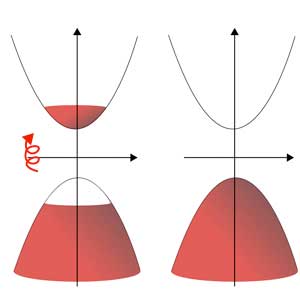| Posted: Aug 25, 2017 |
Light forces electrons to follow the curve in 2D materials
(Nanowerk News) An exotic phenomenon usually associated with high magnetic fields can be achieved without a magnetic field, according to theoretical predictions by researchers from A*STAR and the United States. Their analysis could open the path to a novel type of optoelectronic device operating at long wavelengths.
|
|
A charged particle in an electric field experiences a force that drives it along the direction of the field, creating a current. The moving particle can also experience a force perpendicular to its motion. This can happen in the presence of a magnetic field for example, and can lead to a range of unusual properties, particularly when the perpendicular component dominates and the electron starts to follow a skewed trajectory. But this so-called Hall regime often requires large magnetic fields which are impractical for real devices.
|
|
Justin Song from the A*STAR Institute of High Performance Computing, working with his colleague Mikhail Kats from the University of Wisconsin-Madison, have theoretically predicted that an unusual Hall-type motion can be harnessed at room temperature and without a magnetic field in a new class of materials known as gapped Dirac materials (Nano Letters, "Giant Hall photoconductivity in narrow-gapped Dirac materials").
|
|
“Dirac materials are semi-metals because of their material symmetries,” explains Song. “Narrow-gapped Dirac materials gently break these symmetries, opening up small bandgaps.”
|
 |
| Circularly polarized light creates electrons in one band structure ‘valley’ and not the other, and this can lead to a Hall effect without a magnetic field. (Image: A*STAR Institute of High Performance Computing)
|
|
The alternative route to a Hall effect investigated by Song and Kats is based on so-called ‘valleys’ in these gapped Dirac materials. A valley, in the context of the electronic band structure of a material, is a minimum into which electrons can settle. If there are two valleys with identical energy, the electrons in each of the valleys of gapped Dirac materials feature contrasting trajectories.
|
|
Song and Kats exploited this contrast by inducing an imbalance of electrons in one valley over the other via circularly polarized light illumination. They revealed a photo-induced Hall effect (Hall photoconductivity) with strength determined heavily by the wavelength of the light, increasing by a factor of up to one million when switching from visible light to the far infrared.
|
|
This means that gapped Dirac materials with a smaller electronic bandgap, such as graphene–boron-nitride heterostructures, are more effective than those with a larger bandgap including molybdenum disulfide.
|
|
This phenomenon could be useful for the development of novel far infrared and terahertz optoelectronics. “A particularly tantalizing prospect is a new type of photodetector concept that measures the Hall current in these gapped Dirac materials,” says Song. “Such a photodetector could potentially possess zero net dark current even with a large bias voltage.”
|

